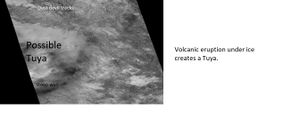Sisyphi Montes
Sisyphi Montes is a mountain range within Sisyphi Planum in the Mare Australe quadrangle. It's exact center is 69.65 S and 13.08 E.It has a diameter of 200 km. The name Sisyphi Montes is a classical albedo name. This name was approved by International Astronomical Union in 1985.[1] The classical name comes from the myth of Sisyphus, in Greek mythology. Sisyphus, the king of Corinth, was punished in Hades by having to roll a huge stone up a hill only to have it roll down again as soon as he had brought it to the top. He had to do this over and over again.[2] This myth sounds like how many people feel about their lives—working all the time, but never getting ahead. Sisyphi Montes are located in the Mare Australe quadrangle, between Argyre and Hellas impact basins.[3]
Ice Sheet
Some researchers have proposed that a large ice sheet covered much of the Mare Australe quadrangle.[4] [5] [6] Sisyphi Montes consists of about 100 dome-like structures, called "Tuya," that resemble volcanoes that have erupted under ice sheets on the Earth.[7] Similar shapes are present in Iceland. Because these domes are some distance from the present ice sheet (1,600 kilometers), so the ice cap in the past would have been way bigger and held much more water. The current Southern cap is only about 350 kilometers across.[8] Measurements with the Compact Reconnaissance Imaging Spectrometer for Mars (CRISM) detected minerals that are formed when a volcano erupts under an ice sheet. Some of the minerals found are clays, sulfates, Iron oxides, and zeolites. This combination is often called palagonite.[9] [10] When volcanoes erupt under an ice sheet large amounts of warm water are created. Masses of warm water under Martian ice could provide suitable places for life to exist. Such environments are also good for preserving fossils.[11]
Note that in the past, Mars had periods when its poles pointed more directly at the sun. During these periods, ice and snow would build up on the side facing away from the sun, and then melt the following local spring. It is unknown if the layers of snow and ice during such periods would build up a thick enough ice sheet to explain the geology found.
References
- ↑ https://planetarynames.wr.usgs.gov/Feature/5580;jsessionid=2E86E770435EBDF1307233BC8484CCE8
- ↑ https://www.britannica.com/topic/Sisyphus
- ↑ https://cosmochemistry-papers.com/2018/04/24/mineralogic-evidence-for-subglacial-volcanism-in-the-sisyphi-montes-region-of-mars/
- ↑ Cassanelli, J. and J. Head. 2015. Firn densification in a Late Noachian "icy highlands" Mars: implications for ice sheet evolution and thermal response. Icarus: 253, 243-255.
- ↑ Fastook, J. and J. Head. 2015. Glaciation in the Late Noachian Icy highlands: ice accumulation, distribution, flow rates, basal melting, and top-down melting rates and patterns. Planet. Space Sci. 106, 82-98.
- ↑ Smellie, J., B. Edwards. 2016. Glaciovolcanism on Earth and Mars. Cambridge University Press.
- ↑ Campbell, A., et al. 2016. Morphology of Possible Subglacial Volcanoes in the Sysphi Montes Region of Mars. 47, 1554
- ↑ http://crism.jhuapl.edu/newscenter/articles/20160503.php
- ↑ Ackiss, E., et al. 2016. MINERALOGICAL EVIDENCE FOR SUBGLACIAL VOLCANOES IN THE SISYPHI MONTES REGION OF MARS. Sixth Mars Polar Science Conference (2016) 6086.pd
- ↑ Ackiss, S., et al. 2018. Mineralogic evidence for subglacial volcanism in the Sisyphi Montes region of Mars. Icarus: 311: 357-370.
- ↑ Cousins, C. and I. Crawford. 2011. Volcano-ice interaction as a microbial Habitat on Earth and Mars. Astrobiology: 11, 695-710.







